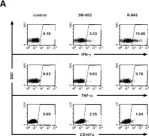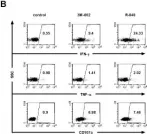Cancer-derived small extracellular vesicles (sEVs) are emerging as crucial mediators of intercellular communication between cancer cells and M2-tumor-associated macrophages (M2-TAMs) via transferring lncRNAs. We previously reported that miR-134 blocks the expression of its targeting protein LAMC2 via the PI3K/AKT pathway and inhibits cancer stem cell (CSC) migration and invasion in oral squamous cell carcinoma (OSCC). This study hypothesize that OSCC-CSC-derived small extracellular vesicles (OSCC-CSC-sEVs) transfer a ceRNA of miR-134 and consequently promote M2 macrophage polarization by targeting LAMC2 via the PI3K/AKT pathway through in vitro and in vivo experiment methods. The results showed that sEVs derived from CD133+CD44+ OSCC cells promoted M2 polarization of macrophages by detecting several M2 macrophage markers (CD163, IL-10, Arg-1, and CD206+CD11b+). Mechanistically, we revealed that the lncRNA UCA1, by binding to miR-134, modulated the PI3K/AKT pathway in macrophages via targeting LAMC2. Importantly, OSCC-CSC-sEV transfer of UCA1, by targeting LAMC2, promoted M2 macrophage polarization and inhibited CD4+ T-cell proliferation and IFN-γ production in vitro and in vivo. Functionally, we demonstrated that M2-TAMs, by transferring exosomal UCA and consequently targeting LAMC2, enhanced cell migration and invasion of OSCC in vitro and the tumorigenicity of OSCC xenograft in nude mice. In conclusion, our results indicated that OSCC-CSC-sEV transfer of UCA1 promotes M2 macrophage polarization via a LAMC2-mediated PI3K/AKT axis, thus facilitating tumor progression and immunosuppression. Our findings provide a new understanding of OSCC-CSC molecular mechanisms and suggest a potential therapeutic strategy for OSCC through targeting CSC-sEVs and M2-TAMs.
Copyright © 2022 Lan Wu et al.
Product Citations: 41
In Stem Cells International on 10 December 2022 by Wu, L., Ye, S., et al.
-
FC/FACS
-
Homo sapiens (Human)
-
Cancer Research
-
Immunology and Microbiology
-
Stem Cells and Developmental Biology
In Science Translational Medicine on 16 March 2022 by Charmetant, X., Espi, M., et al.
Transplant recipients, who receive therapeutic immunosuppression to prevent graft rejection, are characterized by high coronavirus disease 2019 (COVID-19)-related mortality and defective response to vaccines. We observed that previous infection with severe acute respiratory syndrome coronavirus 2 (SARS-CoV-2), but not the standard two-dose regimen of vaccination, provided protection against symptomatic COVID-19 in kidney transplant recipients. We therefore compared the cellular and humoral immune responses of these two groups of patients. Neutralizing anti-receptor-binding domain (RBD) immunoglobulin G (IgG) antibodies were identified as the primary correlate of protection for transplant recipients. Analysis of virus-specific B and T cell responses suggested that the generation of neutralizing anti-RBD IgG may have depended on cognate T-B cell interactions that took place in germinal center, potentially acting as a limiting checkpoint. High-dose mycophenolate mofetil, an immunosuppressive drug, was associated with fewer antigen-specific B and T follicular helper (TFH) cells after vaccination; this was not observed in patients recently infected with SARS-CoV-2. Last, we observed that, in two independent prospective cohorts, administration of a third dose of SARS-CoV-2 mRNA vaccine restored neutralizing titers of anti-RBD IgG in about 40% of individuals who had not previously responded to two doses of vaccine. Together, these findings suggest that a third dose of SARS-CoV-2 mRNA vaccine improves the RBD-specific responses of transplant patients treated with immunosuppressive drugs.
-
COVID-19
-
Genetics
-
Immunology and Microbiology
The SARS-CoV-2 Lambda variant exhibits enhanced infectivity and immune resistance.
In Cell Reports on 11 January 2022 by Kimura, I., Kosugi, Y., et al.
SARS-CoV-2 Lambda, a variant of interest, has spread in some South American countries; however, its virological features and evolutionary traits remain unclear. In this study, we use pseudoviruses and reveal that the spike protein of the Lambda variant is more infectious than that of other variants due to the T76I and L452Q mutations. The RSYLTPGD246-253N mutation, a unique 7-amino acid deletion in the N-terminal domain of the Lambda spike protein, is responsible for evasion from neutralizing antibodies and further augments antibody-mediated enhancement of infection. Although this mutation generates a nascent N-linked glycosylation site, the additional N-linked glycan is dispensable for the virological property conferred by this mutation. Since the Lambda variant has dominantly spread according to the increasing frequency of the isolates harboring the RSYLTPGD246-253N mutation, our data suggest that the RSYLTPGD246-253N mutation is closely associated with the substantial spread of the Lambda variant in South America.Copyright © 2021 The Author(s). Published by Elsevier Inc. All rights reserved.
-
COVID-19
-
Immunology and Microbiology
In Oncoimmunology on 10 August 2021 by Bonte, S., De Munter, S., et al.
T cell receptor (TCR)-redirected T cells target intracellular antigens such as Wilms' tumor 1 (WT1), a tumor-associated antigen overexpressed in several malignancies, including acute myeloid leukemia (AML). For both chimeric antigen receptor (CAR)- and TCR-redirected T cells, several clinical studies indicate that T cell subsets with a less-differentiated phenotype (e.g. stem cell memory T cells, TSCM) survive longer and mediate superior anti-tumor effects in vivo as opposed to more terminally differentiated T cells. Cytokines added during in vitro and ex vivo culture of T cells play an important role in driving the phenotype of T cells for adoptive transfer. Using the OP9-DL1 co-culture system, we have shown previously that we are able to generate in vitro, starting from clinically relevant stem cell sources, T cells with a single tumor antigen (TA)-specific TCR. This method circumvents possible TCR chain mispairing and unwanted toxicities that might occur when introducing a TA-specific TCR in peripheral blood lymphocytes. We now show that we are able to optimize our in vitro culture protocol, by adding IL-21 during maturation, resulting in generation of TA-specific T cells with a less-differentiated phenotype and enhanced in vitro anti-tumor effects. We believe the favorable TSCM-like phenotype of these in vitro generated T cells preludes superior in vivo persistence and anti-tumor efficacy. Therefore, these TA-specific T cells could be of use as a valuable new form of patient-tailored T cell immunotherapy for malignancies for which finding a suitable CAR-T target antigen is challenging, such as AML.
© 2021 The Author(s). Published with license by Taylor & Francis Group, LLC.
-
FC/FACS
-
Cancer Research
-
Immunology and Microbiology
SARS-CoV-2 spike L452R variant evades cellular immunity and increases infectivity.
In Cell Host & Microbe on 14 July 2021 by Motozono, C., Toyoda, M., et al.
Many SARS-CoV-2 variants with naturally acquired mutations have emerged. These mutations can affect viral properties such as infectivity and immune resistance. Although the sensitivity of naturally occurring SARS-CoV-2 variants to humoral immunity has been investigated, sensitivity to human leukocyte antigen (HLA)-restricted cellular immunity remains largely unexplored. Here, we demonstrate that two recently emerging mutations in the receptor-binding domain of the SARS-CoV-2 spike protein, L452R (in B.1.427/429 and B.1.617) and Y453F (in B.1.1.298), confer escape from HLA-A24-restricted cellular immunity. These mutations reinforce affinity toward the host entry receptor ACE2. Notably, the L452R mutation increases spike stability, viral infectivity, viral fusogenicity, and thereby promotes viral replication. These data suggest that HLA-restricted cellular immunity potentially affects the evolution of viral phenotypes and that a further threat of the SARS-CoV-2 pandemic is escape from cellular immunity.
Copyright © 2021 The Authors. Published by Elsevier Inc. All rights reserved.
-
COVID-19
-
Immunology and Microbiology
In PLoS One on 24 April 2008 by Schlaepfer, E. & Speck, R. F.
Fig.4.A

-
FC/FACS
-
Homo sapiens (Human)
Collected and cropped from PLoS One by CiteAb, provided under a CC-BY license
Image 1 of 2
In PLoS One on 24 April 2008 by Schlaepfer, E. & Speck, R. F.
Fig.4.B

-
FC/FACS
-
Homo sapiens (Human)
Collected and cropped from PLoS One by CiteAb, provided under a CC-BY license
Image 1 of 2

